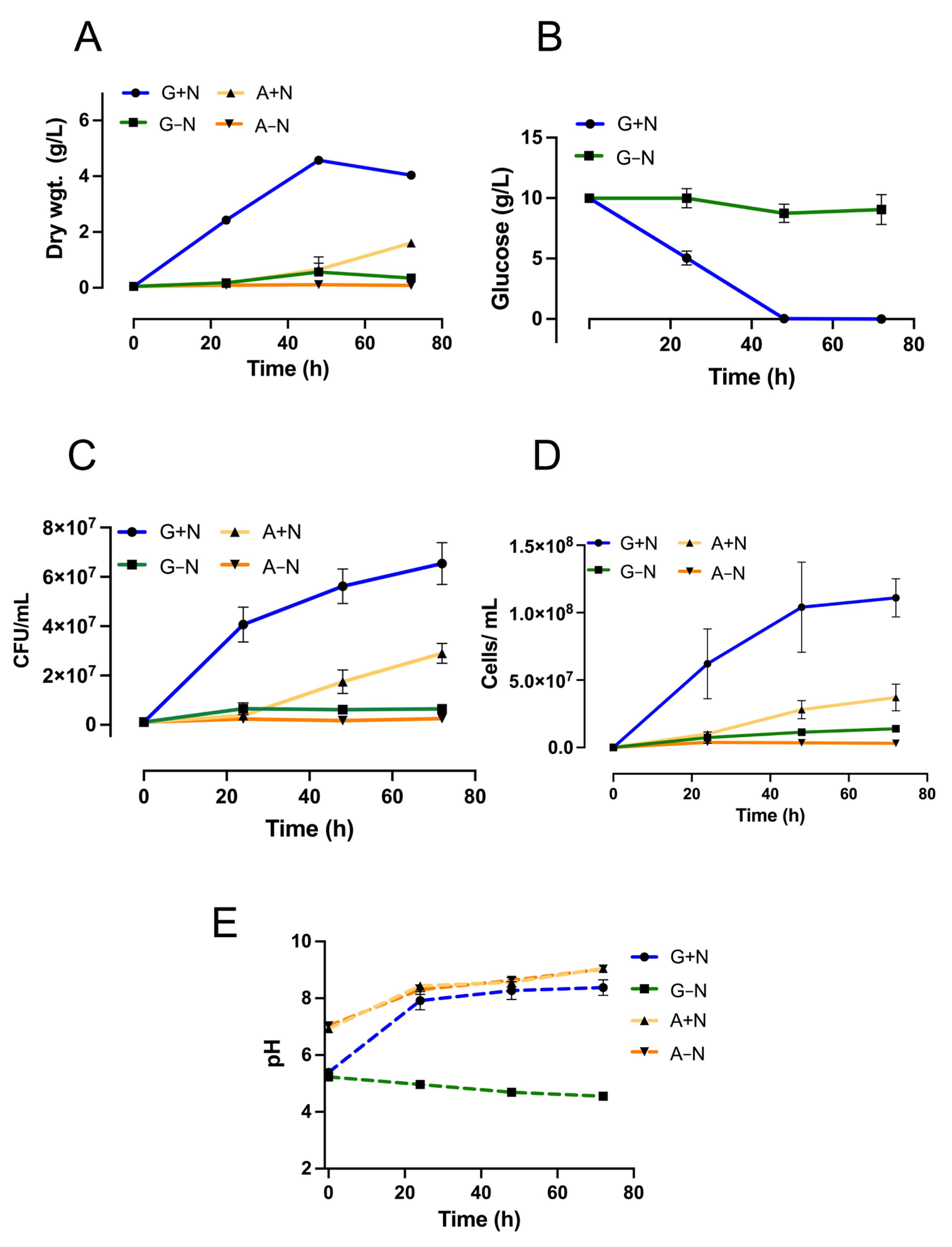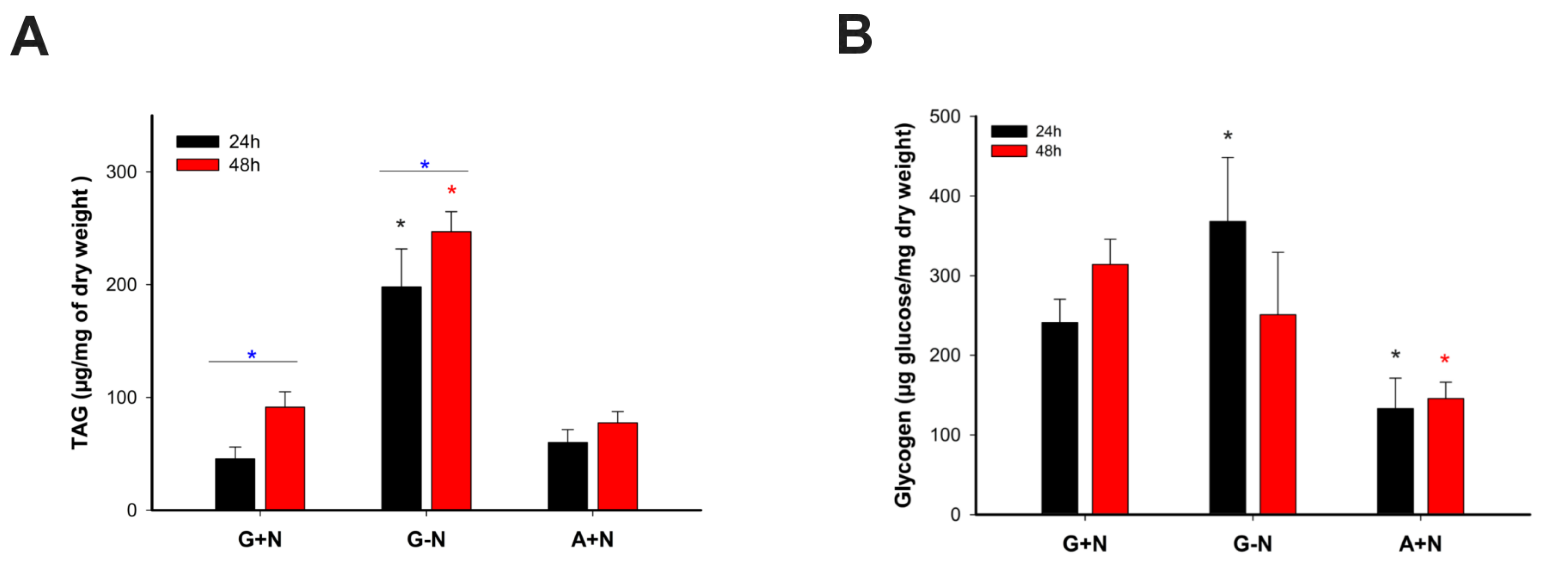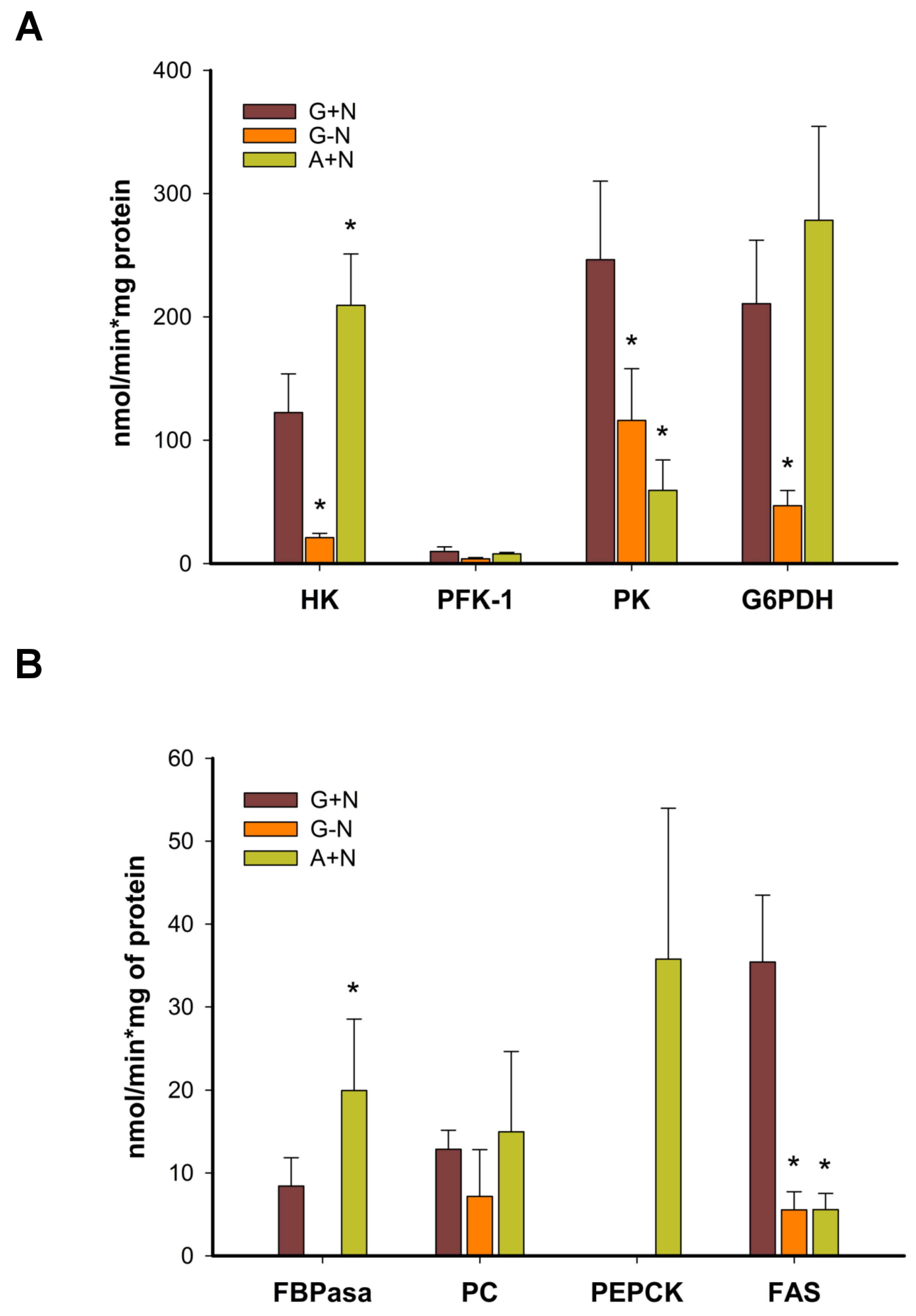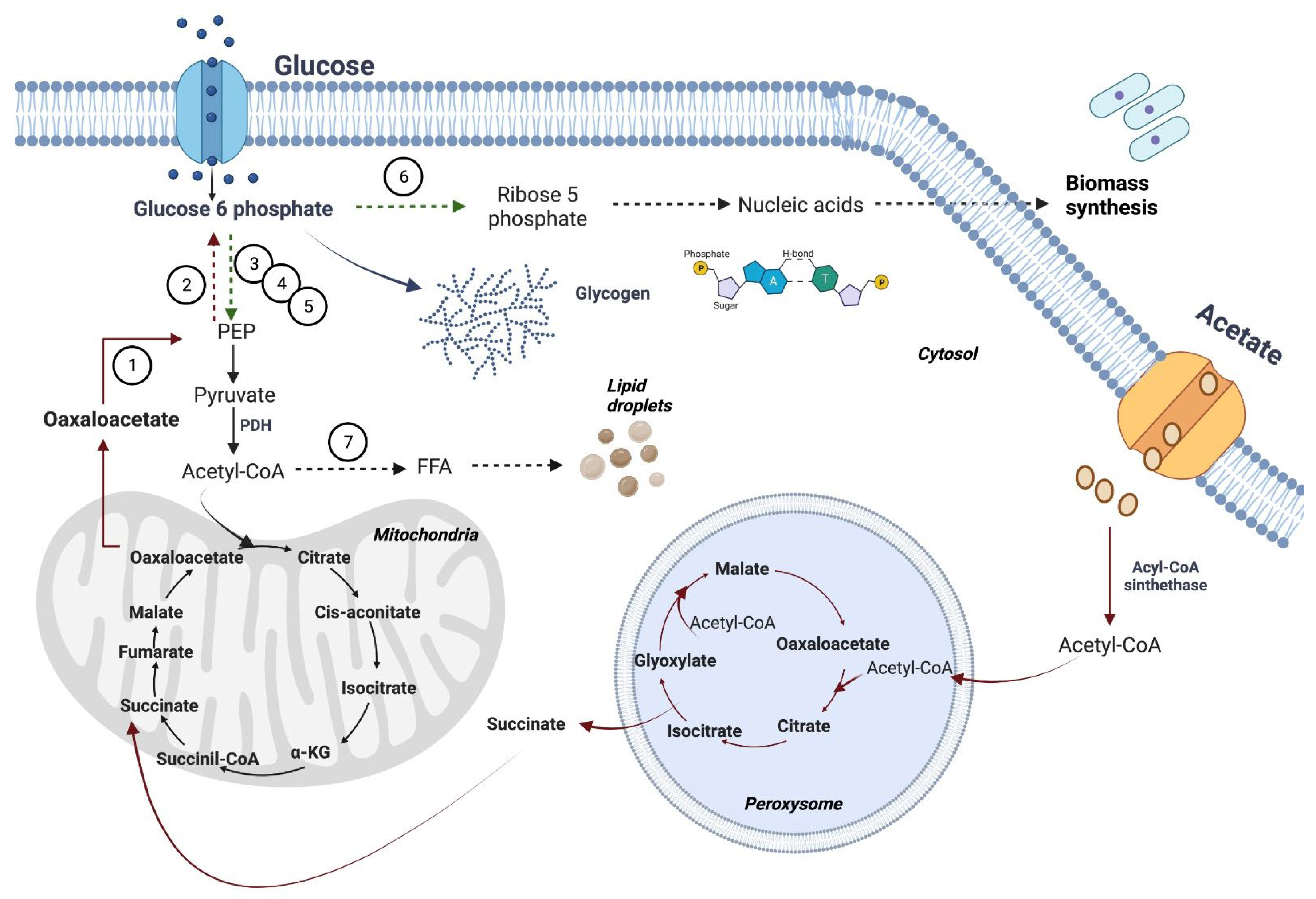Metabolic Changes and Antioxidant Response in Ustilago maydis Grown in Acetate
Abstract
1. Introduction
2. Materials and Methods
2.1. Strains and Growth Conditions
2.2. Dry Weight Determination
2.3. Colony Forming Units
2.4. Total Number of Cells
2.5. Glucose Consumption
2.6. Flow Cytometry
2.7. Hydrogen Peroxide Production
2.8. Confocal Microscopy
2.9. Triacylglycerol Quantification
2.10. Glycogen Quantification
2.11. Preparation of Cell-Free Extracts
2.12. Glutathione Reductase
2.13. Glutathione Peroxidase
2.14. Superoxide Dismutase
2.15. Catalase-Peroxidase
2.16. Hexokinase
2.17. Phosphofructokinase
2.18. Pyruvate Kinase
2.19. Glucose-6-Phosphate Dehydrogenase
2.20. Fructose-1, 6-Bisphosphatase
2.21. Pyruvate Carboxylase
2.22. Fatty Acid Synthase
2.23. Phosphoenolpyruvate Carboxykinase
2.24. pH Determination
2.25. Cell Viability by Flow Cytometry
3. Results
3.1. Growth of Ustilago Maydis in Media with Acetate or Glucose
3.2. Acetate Does Not Promote Lipid Accumulation
3.3. Acetate Promotes Glycogen Synthesis
3.4. Acetate Carbons Are Used to Activate Gluconeogenesis
3.5. Acetate Induces the Production of Hydrogen Peroxide
4. Discussion
4.1. Growth and Cell Viability on Acetate as a Carbon Source
4.2. Acetate and the Synthesis of TAGs and Glycogen
4.3. Acetate and Futile Cycles
5. Conclusions
Author Contributions
Funding
Institutional Review Board Statement
Informed Consent Statement
Data Availability Statement
Acknowledgments
Conflicts of Interest
References
- Olicón-Hernández, D.R.; Araiza-Villanueva, M.G.; Pardo, J.P.; Aranda, E.; Guerra-Sánchez, G. New Insights of Ustilago Maydis as Yeast Model for Genetic and Biotechnological Research: A Review. Curr. Microbiol. 2019, 76, 917–926. [Google Scholar] [CrossRef] [PubMed]
- Steinberg, G.; Perez-Martin, J. Ustilago maydis, a New Fungal Model System for Cell Biology. Trends Cell Biol. 2008, 18, 61–67. [Google Scholar] [CrossRef] [PubMed]
- Dürrenberger, F.; Wong, K.; Kronstad, J.W. Identification of a CAMP-Dependent Protein Kinase Catalytic Subunit Required for Virulence and Morphogenesis in Ustilago maydis. Proc. Natl. Acad. Sci. USA 1998, 95, 5684–5689. [Google Scholar] [CrossRef] [PubMed]
- Vollmeister, E.; Schipper, K.; Baumann, S.; Haag, C.; Pohlmann, T.; Stock, J.; Feldbrügge, M. Fungal Development of the Plant Pathogen Ustilago maydis. FEMS Microbiol. Rev. 2012, 36, 59–77. [Google Scholar] [CrossRef] [PubMed]
- Zarnack, K.; Feldbrügge, M. Microtubule-Dependent MRNA Transport in Fungi. Eukaryot. Cell 2010, 9, 982–990. [Google Scholar] [CrossRef]
- Kretschmer, M.; Lambie, S.; Croll, D.; Kronstad, J.W. Acetate Provokes Mitochondrial Stress and Cell Death in Ustilago maydis. Mol. Microbiol. 2018, 107, 488–507. [Google Scholar] [CrossRef]
- Salmerón-Santiago, K.G.; Pardo, J.P.; Flores-Herrera, O.; Mendoza-Hernández, G.; Miranda-Arango, M.; Guerra-Sánchez, G. Response to Osmotic Stress and Temperature of the Fungus Ustilago maydis. Arch. Microbiol. 2011, 193, 701–709. [Google Scholar] [CrossRef]
- Cárdenas-Monroy, C.A.; Pohlmann, T.; Piñón-Zárate, G.; Matus-Ortega, G.; Guerra, G.; Feldbrügge, M.; Pardo, J.P. The Mitochondrial Alternative Oxidase Aox1 Is Needed to Cope with Respiratory Stress but Dispensable for Pathogenic Development in Ustilago maydis. PLoS ONE 2017, 12, e0173389. [Google Scholar] [CrossRef]
- Romero-Aguilar, L.; Vázquez-Meza, H.; Guerra-Sánchez, G.; Luqueño-Bocardo, O.I.; Pardo, J.P. The Mitochondrial Alternative Oxidase in Ustilago maydis Is Not Involved in Response to Oxidative Stress Induced by Paraquat. J. Fungi 2022, 8, 1221. [Google Scholar] [CrossRef]
- Estrada, A.F.; Brefort, T.; Mengel, C.; Díaz-Sánchez, V.; Alder, A.; Al-Babili, S.; Avalos, J. Ustilago maydis Accumulates Beta-Carotene at Levels Determined by a Retinal-Forming Carotenoid Oxygenase. Fungal Genet. Biol. 2009, 46, 803–813. [Google Scholar] [CrossRef]
- Lee, J.; Hilgers, F.; Loeschke, A.; Jaeger, K.-E.; Feldbrügge, M. Ustilago maydis Serves as a Novel Production Host for the Synthesis of Plant and Fungal Sesquiterpenoids. Front. Microbiol. 2020, 11, 1655. [Google Scholar] [CrossRef]
- Müntjes, K.; Philipp, M.; Hüsemann, L.; Heucken, N.; Weidtkamp-Peters, S.; Schipper, K.; Zurbriggen, M.D.; Feldbrügge, M. Establishing Polycistronic Expression in the Model Microorganism Ustilago maydis. Front. Microbiol. 2020, 11, 1384. [Google Scholar] [CrossRef]
- Philipp, M.; Hussnaetter, K.P.; Reindl, M.; Müntjes, K.; Feldbrügge, M.; Schipper, K. A Novel Potent Carrier for Unconventional Protein Export in Ustilago maydis. Front. Cell Dev. Biol. 2022, 9, 816335. [Google Scholar] [CrossRef]
- Zambanini, T.; Hosseinpour Tehrani, H.; Geiser, E.; Merker, D.; Schleese, S.; Krabbe, J.; Buescher, J.M.; Meurer, G.; Wierckx, N.; Blank, L.M. Efficient Itaconic Acid Production from Glycerol with Ustilago Vetiveriae TZ1. Biotechnol. Biofuels 2017, 10, 131. [Google Scholar] [CrossRef]
- Yocum, H.C.; Bassett, S.; Da Silva, N.A. Enhanced Production of Acetyl-CoA-Based Products via Peroxisomal Surface Display in Saccharomyces cerevisiae. Proc. Natl. Acad. Sci. USA 2022, 119, e2214941119. [Google Scholar] [CrossRef]
- Aguilar, L.R.; Pardo, J.P.; Lomelí, M.M.; Bocardo, O.I.L.; Juárez Oropeza, M.A.; Guerra Sánchez, G. Lipid Droplets Accumulation and Other Biochemical Changes Induced in the Fungal Pathogen Ustilago maydis under Nitrogen-Starvation. Arch. Microbiol. 2017, 199, 1195–1209. [Google Scholar] [CrossRef]
- Zhang, S.; Yang, W.; Chen, H.; Liu, B.; Lin, B.; Tao, Y. Metabolic Engineering for Efficient Supply of Acetyl-CoA from Different Carbon Sources in Escherichia coli. Microb. Cell Factories 2019, 18, 130. [Google Scholar] [CrossRef]
- Walkey, C.J.; Luo, Z.; Madilao, L.L.; van Vuuren, H.J.J. The Fermentation Stress Response Protein Aaf1p/Yml081Wp Regulates Acetate Production in Saccharomyces cerevisiae. PLoS ONE 2012, 7, e51551. [Google Scholar] [CrossRef]
- Semchyshyn, H.M.; Abrat, O.B.; Miedzobrodzki, J.; Inoue, Y.; Lushchak, V.I. Acetate but Not Propionate Induces Oxidative Stress in Bakers’ Yeast Saccharomyces cerevisiae. Redox Rep. 2011, 16, 15–23. [Google Scholar] [CrossRef]
- Saavedra, E.; Ramos-Casillas, L.E.; Marín-Hernández, A.; Moreno-Sánchez, R.; Guerra-Sánchez, G. Glycolysis in Ustilago maydis. FEMS Yeast Res. 2008, 8, 1313–1323. [Google Scholar] [CrossRef]
- Romero-Aguilar, L.; Guerra-Sánchez, G.; Tenorio, E.P.; Tapia-Rodriguez, M.; Matus-Ortega, G.; Flores-Herrera, O.; González, J.; Pardo, J.P. Rapamycin Induces Morphological and Physiological Changes without Increase in Lipid Content in Ustilago maydis. Arch. Microbiol. 2020, 202, 1211–1221. [Google Scholar] [CrossRef] [PubMed]
- Jouihan, H. Measurement of Liver Triglyceride Content. Bio-Protocol 2012, 2, e223. [Google Scholar] [CrossRef]
- Zhang, P. Analysis of Mouse Liver Glycogen Content. Bio-Protocol 2012, 2, e186. [Google Scholar] [CrossRef]
- Lowry, O.H.; Rosebrough, N.J.; Farr, A.L.; Randall, R.J. Protein measurement with the folin phenol reagent. J. Biol. Chem. 1951, 193, 265–275. [Google Scholar] [CrossRef] [PubMed]
- Mannervik, B. Measurement of Glutathione Reductase Activity. Curr. Protoc. Toxicol. 1999, 7.2.1–7.2.4. [Google Scholar] [CrossRef]
- Guevara-Flores, A.; Del Arenal, I.P.; Mendoza-Hernández, G.; Pardo, J.P.; Flores-Herrera, O.; Rendón, J.L. Mitochondrial Thioredoxin-Glutathione Reductase from Larval Taenia crassiceps (Cysticerci). J. Parasitol. Res. 2010, 2010, 719856. [Google Scholar] [CrossRef]
- Higuchi, M. Chapter 15—Antioxidant Properties of Wheat Bran against Oxidative Stress. In Wheat and Rice in Disease Prevention and Health; Watson, R.R., Preedy, V.R., Zibadi, S., Eds.; Academic Press: San Diego, CA, USA, 2014; pp. 181–199. ISBN 978-0-12-401716-0. [Google Scholar]
- Nagi, M.N.; al-Bekairi, A.M.; al-Sawaf, H.A. Spectrophotometric Assay for Superoxide Dismutase Based on the Nitroblue Tetrazolium Reduction by Glucose-Glucose Oxidase. Biochem. Mol. Biol. Int. 1995, 36, 633–638. [Google Scholar]
- Senthilkumar, M.; Amaresan, N.; Sankaranarayanan, A. Estimation of Superoxide Dismutase (SOD). In Plant-Microbe Interactions: Laboratory Techniques; Senthilkumar, M., Amaresan, N., Sankaranarayanan, A., Eds.; Springer Protocols Handbooks; Springer: New York, NY, USA, 2021; pp. 117–118. ISBN 978-1-07-161080-0. [Google Scholar]
- Crouch, R.K.; Gandy, S.E.; Kimsey, G.; Galbraith, R.A.; Galbraith, G.M.P.; Buse, M.G. The Inhibition of Islet Superoxide Dismutase by Diabetogenic Drugs. Diabetes 1981, 30, 235–241. [Google Scholar] [CrossRef]
- Aebi, H. [13] Catalase In Vitro. In Methods in Enzymology; Oxygen Radicals in Biological Systems; Academic Press: Cambridge, MA, USA, 1984; Volume 105, pp. 121–126. [Google Scholar]
- Ibraheem, O.; Adewale, I.O.; Afolayan, A. Purification and Properties of Glucose 6-Phosphate Dehydrogenase from Aspergillus aculeatus. J. Biochem. Mol. Biol. 2005, 38, 584–590. [Google Scholar] [CrossRef]
- Opheim, D.; Bernlohr, R. Purification and Regulation of Fructose-1,6-Bisphosphatase from Bacillus licheniformis. J. Biol. Chem. 1975, 250, 3024–3033. [Google Scholar] [CrossRef]
- Meyer, C.R.; Rustin, P.; Wedding, R.T. A Simple and Accurate Spectrophotometric Assay for Phosphoenolpyruvate Carboxylase Activity 1. Plant Physiol 1988, 86, 325–328. [Google Scholar] [CrossRef]
- Kelley, D.S.; Nelson, G.J.; Hunt, J.E. Effect of Prior Nutritional Status on the Activity of Lipogenic Enzymes in Primary Monolayer Cultures of Rat Hepatocytes. Biochem. J. 1986, 235, 87–90. [Google Scholar] [CrossRef]
- Lee, M.H.; Hebda, C.A.; Nowak, T. The Role of Cations in Avian Liver Phosphoenolpyruvate Carboxykinase Catalysis. Activation and Regulation. J. Biol. Chem. 1981, 256, 12793–12801. [Google Scholar] [CrossRef]
- Heldt, H.-W.; Piechulla, B. Chapter 15—Lipids Are Membrane Constituents and Function as Carbon Stores. In Plant Biochemistry, 5th ed.; Heldt, H.-W., Piechulla, B., Eds.; Academic Press: Cambridge, MA, USA, 2021; pp. 335–371. ISBN 978-0-12-818631-2. [Google Scholar]
- Chen, L.; Yan, W.; Qian, X.; Chen, M.; Zhang, X.; Xin, F.; Zhang, W.; Jiang, M.; Ochsenreither, K. Increased Lipid Production in Yarrowia Lipolytica from Acetate through Metabolic Engineering and Cosubstrate Fermentation. ACS Synth. Biol. 2021, 10, 3129–3138. [Google Scholar] [CrossRef]
- Orlandi, I.; Ronzulli, R.; Casatta, N.; Vai, M. Ethanol and Acetate Acting as Carbon/Energy Sources Negatively Affect Yeast Chronological Aging. Oxid. Med. Cell. Longev. 2013, 2013, 802870. [Google Scholar] [CrossRef]
- Casal, M.; Cardoso, H.; Leao, C. Mechanisms Regulating the Transport of Acetic Acid in Saccharomyces cerevisiae. Microbiology 1996, 142 Pt 6, 1385–1390. [Google Scholar] [CrossRef]
- Guaragnella, N.; Bettiga, M. Acetic Acid Stress in Budding Yeast: From Molecular Mechanisms to Applications. Yeast 2021, 38, 391–400. [Google Scholar] [CrossRef]
- Watcharawipas, A.; Watanabe, D.; Takagi, H. Sodium Acetate Responses in Saccharomyces cerevisiae and the Ubiquitin Ligase Rsp5. Front. Microbiol. 2018, 9, 2495. [Google Scholar] [CrossRef]
- Mollapour, M.; Piper, P.W. Hog1 Mitogen-Activated Protein Kinase Phosphorylation Targets the Yeast Fps1 Aquaglyceroporin for Endocytosis, Thereby Rendering Cells Resistant to Acetic Acid. Mol. Cell Biol. 2007, 27, 6446–6456. [Google Scholar] [CrossRef]
- Giannattasio, S.; Guaragnella, N.; Zdralević, M.; Marra, E. Molecular Mechanisms of Saccharomyces Cerevisiae Stress Adaptation and Programmed Cell Death in Response to Acetic Acid. Front. Microbiol. 2013, 4, 33. [Google Scholar] [CrossRef]
- Liu, Z.; Liu, L.; Wen, P.; Li, N.; Zong, M.; Wu, H. Effects of Acetic Acid and PH on the Growth and Lipid Accumulation of the Oleaginous Yeast Trichosporon Fermentans. BioResources 2015, 10, 4152–4166. [Google Scholar] [CrossRef]
- Chaves, S.R.; Rego, A.; Martins, V.M.; Santos-Pereira, C.; Sousa, M.J.; Côrte-Real, M. Regulation of Cell Death Induced by Acetic Acid in Yeasts. Front. Cell Dev. Biol. 2021, 9, 642375. [Google Scholar] [CrossRef] [PubMed]
- Ogata, K.; Nishikawa, H.; Ohsugi, M. Acetate Utilization for Yeast Cell Growth as Sole Carbon Source. Agric. Biol. Chem. 1969, 33, 977–978. [Google Scholar] [CrossRef]
- Bogonez, E.; Machado, A.; Satrústegui, J. Ammonia Accumulation in Acetate-Growing Yeast. Biochim. Biophys. Acta BBA-Biomembr. 1983, 733, 234–241. [Google Scholar] [CrossRef] [PubMed]
- Verduyn, C.; Stouthamer, A.H.; Scheffers, W.A.; van Dijken, J.P. A Theoretical Evaluation of Growth Yields of Yeasts. Antonie van Leeuwenhoek 1991, 59, 49–63. [Google Scholar] [CrossRef]
- Wasylenko, T.M.; Ahn, W.S.; Stephanopoulos, G. The Oxidative Pentose Phosphate Pathway Is the Primary Source of NADPH for Lipid Overproduction from Glucose in Yarrowia Lipolytica. Metab. Eng. 2015, 30, 27–39. [Google Scholar] [CrossRef]







| Enzyme | Growth Conditions/Metabolic Pathway | ||
|---|---|---|---|
| Gluconeogenesis (nmol min−1 mg protein−1) | |||
| G+N | G-N | A+N | |
| HK | 122 ± 31 | 21 ± 3.5 | 210 ± 41 |
| PFK1 | 9.8 ± 4 | 3.8 ± 1.0 | 7.9 ± 1.16 |
| PK | 246 ± 64 | 116 ± 42 | 59 ± 24 |
| Pentose phosphate pathway (nmol min−1 mg protein−1) | |||
| G+N | G-N | A+N | |
| G6PDH | 210 ± 51 | 47 ± 12 | 278 ± 76 |
| Gluconeogenesis enzymes (nmol min−1 mg protein−1) | |||
| G+N | G-N | A+N | |
| PEPCK | N.D | N.D | 36 ± 18 |
| FBPase | 8.4 ± 3.4 | N.D | 20 ± 8.6 |
| Lipid synthesis (nmol min−1 mg protein−1) | |||
| G+N | G-N | A+N | |
| FAS | 35 ± 8 | 5.5 ± 2 | 5.5 ± 2 |
| Antioxidant enzymes (nmol min−1 mg protein−1) | |||
| G+N | G-N | A+N | |
| GSH-Px | 19 ± 5 | 2.8 ± 1.4 | 83 ± 36 |
| GSH-Rd | 36 ± 10 | 8 ± 6 | 134 ± 40 |
| Cat | 6200 ± 300 | 3200 ± 1100 | 10,400 ± 2800 |
| SOD | 38 ± 1.6 | 18 ± 5 | 46.5 ± 4.8 |
Disclaimer/Publisher’s Note: The statements, opinions and data contained in all publications are solely those of the individual author(s) and contributor(s) and not of MDPI and/or the editor(s). MDPI and/or the editor(s) disclaim responsibility for any injury to people or property resulting from any ideas, methods, instructions or products referred to in the content. |
© 2023 by the authors. Licensee MDPI, Basel, Switzerland. This article is an open access article distributed under the terms and conditions of the Creative Commons Attribution (CC BY) license (https://creativecommons.org/licenses/by/4.0/).
Share and Cite
Romero-Aguilar, L.; Hernández-Morfín, K.D.; Guerra-Sánchez, G.; Pardo, J.P. Metabolic Changes and Antioxidant Response in Ustilago maydis Grown in Acetate. J. Fungi 2023, 9, 749. https://doi.org/10.3390/jof9070749
Romero-Aguilar L, Hernández-Morfín KD, Guerra-Sánchez G, Pardo JP. Metabolic Changes and Antioxidant Response in Ustilago maydis Grown in Acetate. Journal of Fungi. 2023; 9(7):749. https://doi.org/10.3390/jof9070749
Chicago/Turabian StyleRomero-Aguilar, Lucero, Katia Daniela Hernández-Morfín, Guadalupe Guerra-Sánchez, and Juan Pablo Pardo. 2023. "Metabolic Changes and Antioxidant Response in Ustilago maydis Grown in Acetate" Journal of Fungi 9, no. 7: 749. https://doi.org/10.3390/jof9070749
APA StyleRomero-Aguilar, L., Hernández-Morfín, K. D., Guerra-Sánchez, G., & Pardo, J. P. (2023). Metabolic Changes and Antioxidant Response in Ustilago maydis Grown in Acetate. Journal of Fungi, 9(7), 749. https://doi.org/10.3390/jof9070749






